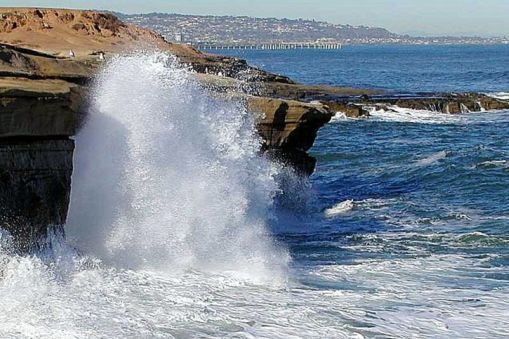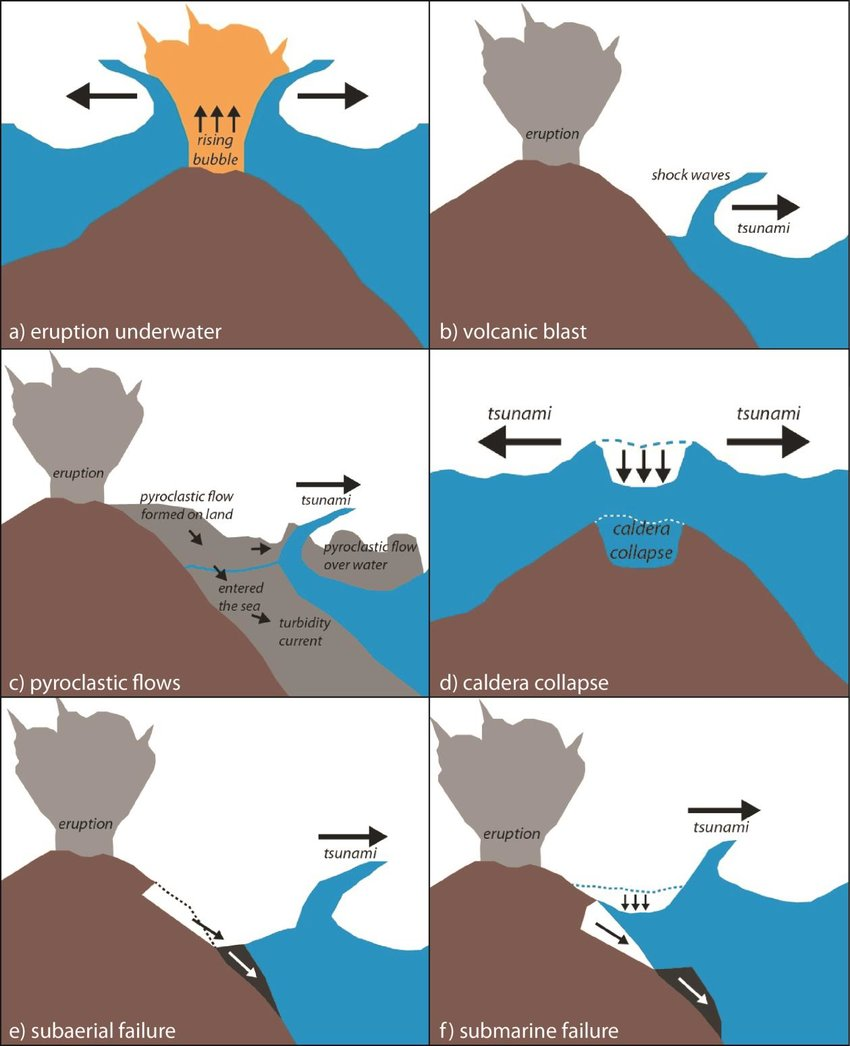#EAPS#EAPS106
Tsunamis Caused by Earthquakes §
- A tsunami is a wave caused by the displacement of a large volume of water, usually caused by subduction zone earthquakes
- It can be devastating to people near the shore when the wave hits
- Tsunamis have so much weight behind them that they can destroy buildings in their path, along with vegetation on the ground
- People caught in tsunamis are often crushed before they can drown because of the great quantity of debris swept inland
- During a subduction zone earthquake, elastic rebound of the overriding plate causes uplift of the seafloor
- This causes a mountain of water to form at the surface that then falls away to generate tsunami waves in both directions
- Earthquake generated tsunamis are generally associated with a M9 or larger earthquake that ruptures 100s of miles of a fault, leading to waves hitting 100s of miles of coastline
- The 2004 Sumatra tsunami was caused by a subduction zone earthquake that uplifted the seafloor of a 1000 kilometer long fault
- Because a subduction zone tsunami is initiated on the seafloor, it involves the full depth of the ocean. Thus, tsunami waves are influenced by seafloor topography (called bathymetry), which complicates wave propagation
- A strike slip fault underwater will NOT cause a tsunami
Tsunami Characteristics §
- General Wave terminology
- A crest is where the water is high
- A trough is where the water is low
- Wave length is the distance from crest to crest (or trough to trough)
- Tsunami waves can have similar heights to large wind-blown waves but carry a much larger volume of water, have a larger wavelength, and travel much further inland
- Main difference between a wind blown wave and a tsunami wave is wavelength
- In deep water, tsunami waves have long wavelengths and low wave heights
- As they approach the shore, they slow down. This causes the back of the waves to catch up to the front, reducing wavelength, but increasing wave height
- If you were in a boat, you would never know that a tsunami wave is actually passing underneath you, since it’s height only increases when it gets close to shore
- This is where the name comes from, Tsunami is a Japanese word meaning “Harbor Wave”. Fishing boats in the ocean would feel nothing from the tsunami waves as they pass underneath and return to their villages flooded and destroyed to the tsunami after it hit shore
- In the 2011 Japan tsunami, wave heights in the open ocean were lass than 1 meter, but they reached heights more than 10 meters as they approached the shore
- Tsunami waves, like wind blown waves, break when the wave height is about equal to the water depth. This usually happens close to shore.
- The 2011 Japan Tsunami continued to come on shore for 20 minutes and reach 10 kilometers inland in places
- Inlets (natural harbors) are particularly dangerous places when a tsunami hits because the incoming water becomes trapped and piles up.
- This leads to Japan being in a lot of danger due to tsunamis because it has many many inlets
- Run-up is when the water can’t go anywhere upon hitting a solid surface, such as a cliff. The water then just jumps up into the air, which is run-up. The run-up of a wave can get much taller, but is not the actual wave height
- Run-up in the Japanese inlets caused the water to reach 40 feet in some places, leading to cars and boats on top of houses

- I’m thinking like this kind of thing
Tsunami Accuracy in Movies (this is a movie class) §
- San Andreas (2015)
- Ridiculously large
- They break further from shore then they should
- The San Andreas fault is a strike-slip fault, so it couldn’t cause tsunamis
- ALSO, it’s mostly on land, so it would have no way to cause tsunamis if it could!
- Interstellar
- This is wave is ridiculously tall and narrow
- You can’t have a 1000 foot high wave passes through 1 foot of water WITHOUT breaking
- There is no trough, just a crest
- 2012
- A tsunami wave has no way of getting that far inland and that tall
- The 5th Wave
- Initial lake tsunami is very good
- Ocean wave is ridiculously tall and should’ve broken
- The Impossible
- Hereafter
What should you do if you are in a tsunami? §
- There really is no definitive answer, just hope and pray
Tsunami Mitigation §
- Tsunami’s have killed several hundred thousand people, but today this is potentially one of the most avoidable natural hazards
- We can detect tsunamis and warn people
- The Fukushima Japan nuclear disaster was caused by a tsunami destroying the cooling system for the power plant. Even though the wave heights were unprecedented, they should have been prepared for it.
- Dozens of tsunami stones along the coast of Japan warn residents not to build below them. Some are more than 600 years old. They show how high the water has reached before.
- Tsunami warning signs and what you should do
- Significant seismic shaking near the shore:
- 20-40 minutes before a tsunami hits: head to high ground
- The tide appears to go out very fast and very far:
- 5-10 minutes before the tsunami hits: get to high ground
- Tsunami waves are often preceded by coastal waves being dragged out when the trough of the tsunami wave arrives before the crest
- Massive white water or debris field is heading toward you
- Seconds before the tsunami hits: Need to get to high ground or a high floor immediately (but choose your building wisely! Don’t want one that will get destroyed. Choose a concrete structure if possible)
- Tsunamis consist of 3-10 waves over several hours, and often the 2nd or 3rd wave is the biggest
- Do NOT go back to shore unless given the all clear or many hours have passed
- A combination of earthquake rupture complexity, rebounds off near shores, and the effects of seafloor bathymetry cause multiple tsunami waves.
- Buried sand deposits along the coast of the Pacific northwest reveal a history of large tsunamis
- Tsunami seawalls are walls designed to hold water back and protect civilization. They don’t always work though, water can still pile up and get over them eventually
- Elevated platforms were designed to protect people who did not have time to escape. However, the water is often taller than those platforms
- It can take less than a day (~ 7 hours?) for a tsunami wave to cross the ocean
- Deep ocean Assessment and Reporting of Tsunamis (DART) Early Warning System
- The DART early warning system can send out tsunami warnings in as little as 15 minutes after an earthquake including path and size estimates
- The key is the pressure sensor on the seafloor. There’s a sensor on the seafloor that can detect tsunami waves, which then transmits information to a buoy, to a satellite, to a station on land.
- These early warning systems were not in place for the 2004 Sumatra Tsunami, leading to people not being notified across the pacific and leading to many deaths.
Landslide Induced Tsunamis §
- A tsunami can be caused by any process that displaces a large volume of water
- Even Godzilla could cause a tsunami!
- Many ways to cause tsunamis
- Earthquakes
- Submarine (underwater) explosions
- Landslides
- Asteroid Impacts
- These can make the largest tsunamis but are very rare
- Weather disturbances
- In 1958 a tsunami generated by an avalanche (landslide) in Lituya Bay, Alaska, caused the highest runup ever recorded.
- Some of the largest tsunamis are generated by rockslides from steep cliffs into fjords carved by glaciers
- Landslides in Akerneset cliffs of Norway have produced 300 foot high tsunamis that race through the fjord, reaching Geiranger on the other side of the fjord in about 10 minutes.
- The people there live with that threat, and do their best to be ready.
Volcano and Asteroid Tsunamis §
- Volcanoes can cause tsunamis in a number of ways
- Pyroclastic flows from volcanic eruptions can cause a tsunami by pushing water away
- A pyroclastic flow associated with the eruption in Mt. Vesuvius that destroyed Pompeii caused a small tsunami
- Underwater landslides on the islands of Hawaii have caused numerous tsunamis
- Today the southern flank of Kilauea Volcano in Hawaii is slowly slumping towards the sea. This means that eventually it will cause a major tsunami. We don’t really get much warning even while we are watching them.
- The Atlantic coasts of Europe, Africa, and the Americas are vulnerable to tsunamis from underwater landslides on volcanoes at the Canary Islands
- The 1883 eruption of Krakatoa caused a tsunami that killed 36,000 people in Indonesia since the volcano is surrounded by a lot of shoreline
- In 2018, Anak Krakatau erupted causing a tsunami that killed 500 people
- Anak Krakatau basically means son of Krakatoa. Like father like son
Asteroids §
- A single point impact will create a circular tsunami wave
- A 1 kilometer asteroid impact could generate a several hundred meter high tsunami
- If a 10 kilometer asteroid (the size of the one that wiped out the dinosaurs) impacted the same place as it did then, you would not survive the resulting tsunami in the southern coast. Florida would be wiped out basically by the waters.

